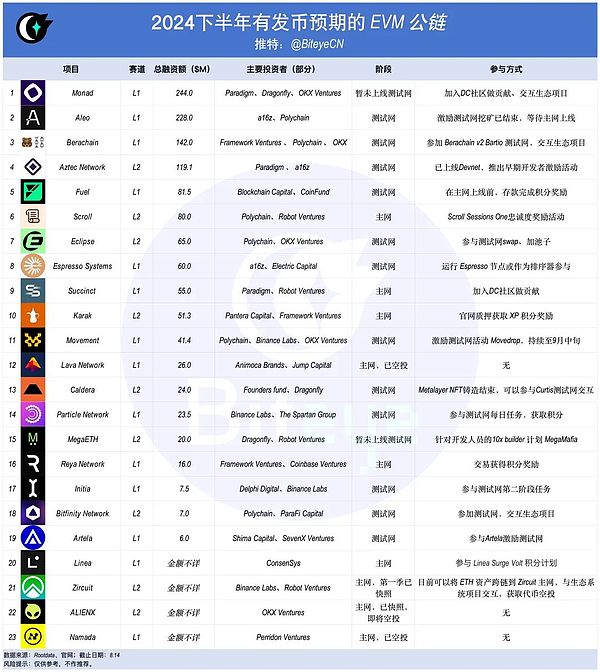
As a pioneer in the blockchain industry, Ethereum has experienced many fluctuations and challenges in recent years.However, as projects are launched one after another, the EVM public chain ecosystem is revitalizing new vitality.
This article will take stock of some EVM public chains that have expected coin issuance in the second half of the year.
01Project inventory

1. Monad: The total financing is US$244 million, invested by Paradigm, Dragonfly, OKX Ventures and others.
A high-performance blockchain platform, compatible with Ethereum Virtual Machine (EVM), aims to significantly improve transaction speed and scalability through parallel execution technology, and can handle over 10,000 transactions per second.
2. Aleo: The total financing is US$228 million, invested by a16z, Polychain and others.
A private public chain based on zero-knowledge proof technology aims to provide highly private smart contracts and decentralized applications.
3. Berachain: The total financing is US$142 million, invested by Framework Ventures, Polychain, OKX and others.
A high-performance EVM compatible blockchain adopts a Proof-of-Liquidity consensus mechanism, aiming to promote the development of the decentralized finance (DeFi) ecosystem.
4. Aztec Network: The total financing is US$119 million, invested by Paradigm, a16z and others.
The first private ZK-rollup on Ethereum, designed to provide privacy protection and scalability for decentralized applications.
5. Fuel: The total financing is 81.5 million US dollars, invested by Blockchain Capital, CoinFund and others.
A modular execution layer designed for Ethereum is designed to achieve efficient blockchain scalability through parallel transaction execution and flexible throughput.
6. Scroll: The total financing is 80 million US dollars, invested by Polychain, Robot Ventures and others.
EVM compatible with zk-Rollup based on zero-knowledge proof technology aims to support the development of decentralized applications by improving Ethereum’s scalability and privacy protection.Allows users to verify transactions without revealing the original data and achieve seamless compatibility with existing Ethereum infrastructure.
7. Eclipse: The total financing is 65 million US dollars, invested by Polychain, OKX Ventures and others.
High-performance Layer 2 solution based on Ethereum, leveraging Solana virtual machine (SVM) for rapid execution.It combines Ethereum’s security and Celestia’s data availability to support high transaction volume and low fees for decentralized application development.
8. Espresso Systems: A total financing of US$60 million, invested by a16z, Electric Capital, etc.
An EVM-compatible blockchain project that uses zk-Rollup and PoS consensus mechanisms to provide scaling and privacy protection, providing high-performance and secure infrastructure for Web3 application development.
9. Succinct: The total financing is 55 million US dollars, invested by Paradigm, Robot Ventures and others.
Projects aimed at establishing an initial decentralized and permissionless interoperability layer for Ethereum, leveraging proof-based cross-chain communications to enable developers to securely integrate the technology into the upcoming dApp project.
10. Karak: The total financing is 51.3 million US dollars, invested by Pantera Capital, Framework Ventures and others.
A Layer 2 blockchain network focused on restaking is designed to incentivize users to restake through points to achieve multiple returns, while supporting asset interactions between the Ethereum mainnet and multiple other blockchain protocols.
11. Movement: The total financing is US$41.4 million, invested by Polychain, Binance Labs, OKX Ventures and others.
Move-based zk-Rollup aims to build and deploy infrastructure and applications based on the Move programming language for distributed environments. It is compatible with the Ethereum ecosystem and promotes liquidity and interoperability between different blockchains.
12. Lava Network: The total financing is US$26 million, invested by Animoca Brands, Jump Capital, etc.
A modular blockchain data market that connects blockchain and decentralized applications with node providers provides flexible data storage and management solutions, aiming to improve the efficiency and scalability of data access.
13. Caldera: The total financing is US$24 million, invested by Founders fund, Dragonfly and others.
A focused on building high-performance, customizable Layer2 blockchain network designed to provide high throughput and low latency solutions for decentralized applications, enabling developers to quickly create application-specific blockchains.
14. Particle Network: The total financing is US$23.5 million, invested by Binance Labs, The Spartan Group, etc.
A modular blockchain project aims to achieve cross-chain interoperability through chain abstraction, enabling users to seamlessly manage and trade assets on different blockchains, simplifying user experience.
15. MegaETH: The total financing is US$20 million, invested by Dragonfly, Robot Ventures and others.
A real-time blockchain fully compatible with Ethereum aims to provide a Web2-like performance experience with ultra-high transaction throughput and low latency processing capabilities, supporting over 100,000 transactions per second.
16. Reya Network: The total financing is 16 million US dollars, invested by Framework Ventures, Coinbase Ventures, etc.
A modular Layer 2 solution focused on trading scenario optimization aims to improve liquidity and capital efficiency of cryptocurrency exchanges through a unique liquidity pool mechanism.
17. Initia: The total financing is US$7.5 million, invested by Delphi Digital, Binance Labs and others.
The modular full-chain Rollup network aims to simplify user experience in multi-chain environments and optimize developers’ application-building capabilities by combining application-specific L2 infrastructure with innovative L1 blockchains.
18. Bitfinity Network: The total financing is US$7 million, invested by Polychain, ParaFi Capital, etc.
An EVM-compatible blockchain built on Internet computers (ICs) ensures security with a threshold signature solution and brings new applications and use cases to the Bitcoin ecosystem through compatibility with the Ethereum ecosystem.
19. Artela: The total financing is 6 million US dollars, invested by Shima Capital, SevenX Ventures and others.
A scalable blockchain network that improves scalability and performance through parallel execution stack and elastic block space technologies, enables developers to build feature-rich dApps in the EVM environment and dynamically adds WASM native extensions to support complexityApplication scenario.
20. Linea: The total financing amount is unknown, and it is invested by ConsenSys and others.
A high-performance Layer 2 network developed by ConsenSys combines zero-knowledge proof technology with full compatibility of Ethereum virtual machines (EVMs), aiming to improve the scalability and development efficiency of decentralized applications.
21. Zircuit: The total financing amount is unknown, and it is invested by Binance Labs, Robot Ventures and others.
A fully EVM-compatible zero-knowledge Rollup network that combines Optimistic Rollup with zero-knowledge proof is designed to provide developers with high performance and security solutions.
22. ALIENX: The total financing amount is unknown, and it is invested by OKX Ventures and others.
A high-performance blockchain powered by AI nodes aims to become the infrastructure for NFTs and gaming, enabling users to earn profits by staking multiple crypto assets and working to improve network security and data credibility.
23. Namada: The total financing amount is unknown, and it is invested by Perridon Ventures and others.
A Layer 1 cross-chain privacy platform based on proof of stake adopts CometBFT consensus mechanism, supports hidden transfers of multiple assets and is compatible with the complete IBC protocol to enhance the privacy protection of the multi-chain ecosystem.
02Summarize
With the continuous development of these EVM public chains, the market’s confidence in the Ethereum ecosystem is gradually recovering.
Although facing challenges such as technological compatibility and security, the emergence of emerging public chains has injected new vitality into the future of Ethereum.
In general, the second half of the year will be a critical period for the EVM public chain to issue coins. Ethereum’s re-greatness may be achieved with the help of these emerging public chains.







